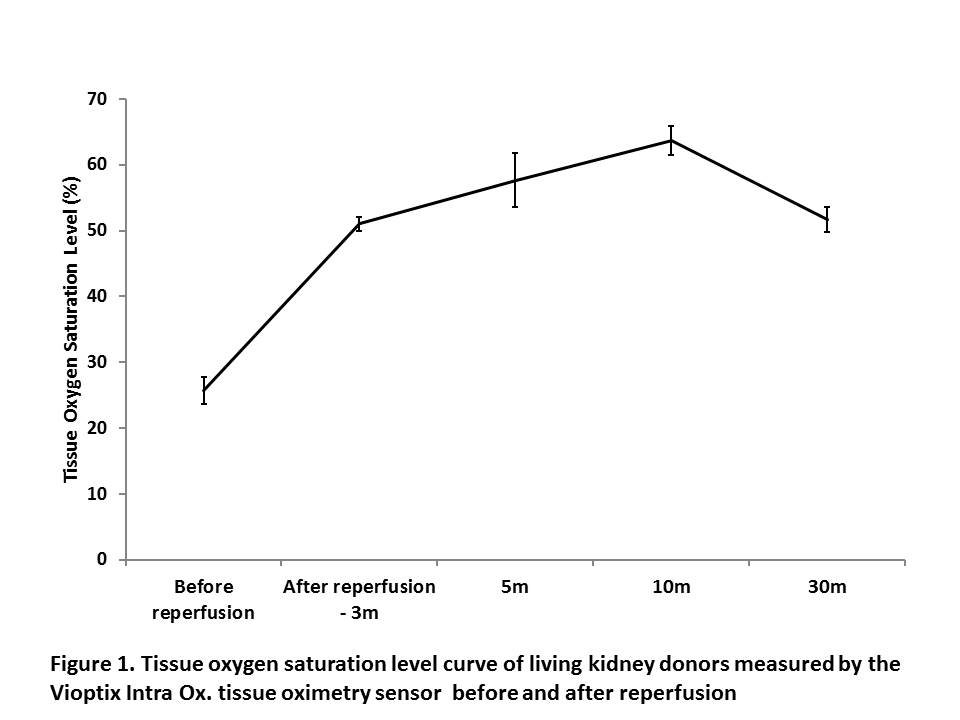Predicting Graft Function And Long-term Outcomes Following Kidney Transplantation Using An Intraoperative Tissue Oximetry Sensor
University of California Irvine, Orange, CA
Meeting: 2019 American Transplant Congress
Abstract number: D259
Keywords: Graft function, Ischemia, Kidney, Monitoring
Session Information
Session Name: Poster Session D: Non-Organ Specific:Organ Preservation/Ischemia Reperfusion Injury
Session Type: Poster Session
Date: Tuesday, June 4, 2019
Session Time: 6:00pm-7:00pm
 Presentation Time: 6:00pm-7:00pm
Presentation Time: 6:00pm-7:00pm
Location: Hall C & D
*Purpose: Marginal kidneys have been increasingly used due to the severe shortage of organs. Deceased-donor kidney transplantation is associated with a higher incidence of delayed graft function (DGF) due to prolonged cold ischemia and reperfusion injuries when compared to living donor kidney transplant. No reliable method has been established to predict the kidney graft function as well as how these events affect long-term outcomes. The aim of this study is to determine whether tissue oxygen saturation level of transplanted kidneys immediately post reperfusion measured by a tissue oximetry sensor recently approved by FDA is correlated to delayed graft function and/or clinical outcomes.
*Methods: During the kidney transplantation procedure, the tissue oxygen saturation level of the transplanted kidney was measured at 3 regions (higher, middle, and lower pole region) using a non-invasive Vioptix Intra Ox. tissue oximetry sensor before and after re-perfusion at 3 minutes, 5 minutes, 10 minutes and 30 minutes. The tissue oxygen saturation level of transplanted kidneys from living donors and deceased donors with different cold ischemic time (CIT) were compared. The incidence of DGF and clinical outcomes were recorded and correlated to the tissue oxygen saturation level.
*Results: The tissue oxygen saturation level before reperfusion and at 3, 5, 10 and 30 minutes after reperfusion in deceased donor kidneys with CIT greater than 24 hours were 35.5 ± 2.9%, 37.7 ± 3.3%, 43.5 ± 4.6%, 46.3 ± 1.9%, and 45.8 ± 2.7%, respectively. The tissue oxygen saturation level of living donor kidneys measured at the same time points were 25.7 ± 2%, 51 ± 1%, 57.8 ± 4.1%, 63.7 ± 2.1%, and 51.7 ± 1.9%, respectively. No DGF was observed in all kidneys. Over 24 hours CIT group with lower oxygen saturation levels showed slow graft function.
*Conclusions: Living donor kidneys have higher oxygen saturation levels and a faster rate of restoring to normal perfusion than deceased donor kidneys. The higher tissue oxygen saturation level is associated with better graft function. The Vioptix Intra Ox. tissue oximetry sensor could be of assistance in predicting kidney graft function.
To cite this abstract in AMA style:
Lau H, Shimomura A, Tantisattamo E, Reddy UG, Dafoe D, Ichii H. Predicting Graft Function And Long-term Outcomes Following Kidney Transplantation Using An Intraoperative Tissue Oximetry Sensor [abstract]. Am J Transplant. 2019; 19 (suppl 3). https://atcmeetingabstracts.com/abstract/predicting-graft-function-and-long-term-outcomes-following-kidney-transplantation-using-an-intraoperative-tissue-oximetry-sensor/. Accessed December 23, 2025.« Back to 2019 American Transplant Congress

